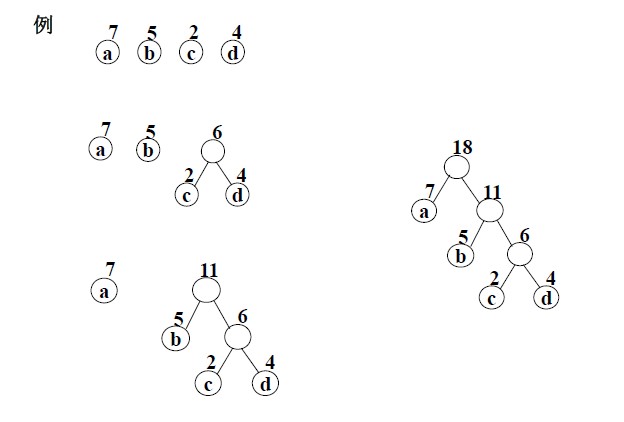哈夫曼树
Posted
tags:
篇首语:本文由小常识网(cha138.com)小编为大家整理,主要介绍了哈夫曼树相关的知识,希望对你有一定的参考价值。
定义:给定n个带有权值的叶节点,将其组成一颗带权路径长度最小的二叉树,则该二叉树为哈夫曼树,亦称最优二叉树
假设叶节点的权值分别为w1, w2, w3 ... wn,到根节点的路径长度分别为l1, l2, l3 ... ln,
那么WPL = w1 * l1 + w2 * l2 + w3 * l3 + ... + wn * ln,哈夫曼树则是WPL最小的树
构成哈夫曼树算法:

样例:

简单示例代码:
// Author: Waihui Zheng // 哈夫曼树 #include <iostream> #include <string> #include <vector> #include <queue> #include <functional> namespace my_space { #define ENDTREE -1 class HaffMan { // 哈夫曼树节点 struct TreeNode { int weight; int parent; int lchild; int rchild; TreeNode(int w = 0) : weight(w), parent(ENDTREE), lchild(ENDTREE), rchild(ENDTREE) {} }; // 信息节点 struct NodeInfo { std::string info; int weight; int location; NodeInfo(const std::string& str = "", int w = 0) : info(str), weight(w), location(ENDTREE) {} }; // 优先队列节点 struct WeightHelper { int weight; int index; WeightHelper(int w = 0, int ix = -1) : weight(w), index(ix) {} bool operator>(const WeightHelper& rhs) const { return weight > rhs.weight; } }; public: HaffMan() {} ~HaffMan() {} void clear() { _node_infos.clear(); _haffman_tree.clear(); } void add_info(const std::string& info, int weight) { _node_infos.push_back(NodeInfo(info, weight)); } void construct_haffman_tree() { // 初始化哈夫曼树,建立n个独立的树 _haffman_tree.clear(); for (int i = 0; i < _node_infos.size(); ++i) { _haffman_tree.push_back(TreeNode(_node_infos[i].weight)); _node_infos[i].location = i; } // 优先队列,内部按权值进行排序 std::priority_queue<WeightHelper, std::vector<WeightHelper>, std::greater<WeightHelper> > pq; for (int i = 0; i < _haffman_tree.size(); ++i) { pq.push(WeightHelper(_haffman_tree[i].weight, i)); } // 生成n-1颗树 int times = _node_infos.size() - 1; while (times--) { // 优先找出两颗根权值最小的两颗 WeightHelper lchild = pq.top(); pq.pop(); WeightHelper rchild = pq.top(); pq.pop(); // 创建新root节点 TreeNode new_tree_node( _haffman_tree[lchild.index].weight + _haffman_tree[rchild.index].weight); new_tree_node.lchild = lchild.index; new_tree_node.rchild = rchild.index; _haffman_tree.push_back(new_tree_node); // 修改子节点父母节点指针指向 _haffman_tree[lchild.index].parent = _haffman_tree.size() - 1; _haffman_tree[rchild.index].parent = _haffman_tree.size() - 1; // 加入新树 pq.push(WeightHelper(new_tree_node.weight, _haffman_tree.size() - 1)); } } std::string get_haffman_code(const std::string& name) { int name_index = 0; for (; name_index < _node_infos.size(); ++name_index) { if (_node_infos[name_index].info == name) { break; } } std::string code; if (name_index == _node_infos.size()) { return code; } int cur_index = _node_infos[name_index].location; int parent_index = _haffman_tree[cur_index].parent; // 回溯寻找 叶子节点到根节点的路径 while (parent_index != ENDTREE) { code.push_back(_haffman_tree[parent_index].lchild == cur_index ? ‘0‘ : ‘1‘); cur_index = parent_index; parent_index = _haffman_tree[cur_index].parent; } std::reverse(code.begin(), code.end()); return code; } void print() { for (int i = 0; i < _node_infos.size(); ++i) { std::cout << _node_infos[i].info << " code: " << get_haffman_code(_node_infos[i].info) << std::endl; } } private: std::vector<NodeInfo> _node_infos; std::vector<TreeNode> _haffman_tree; }; } int main() { my_space::HaffMan haffman_tree; haffman_tree.add_info("A", 7); haffman_tree.add_info("B", 5); haffman_tree.add_info("C", 2); haffman_tree.add_info("D", 4); haffman_tree.construct_haffman_tree(); haffman_tree.print(); return 0; }
以上是关于哈夫曼树的主要内容,如果未能解决你的问题,请参考以下文章